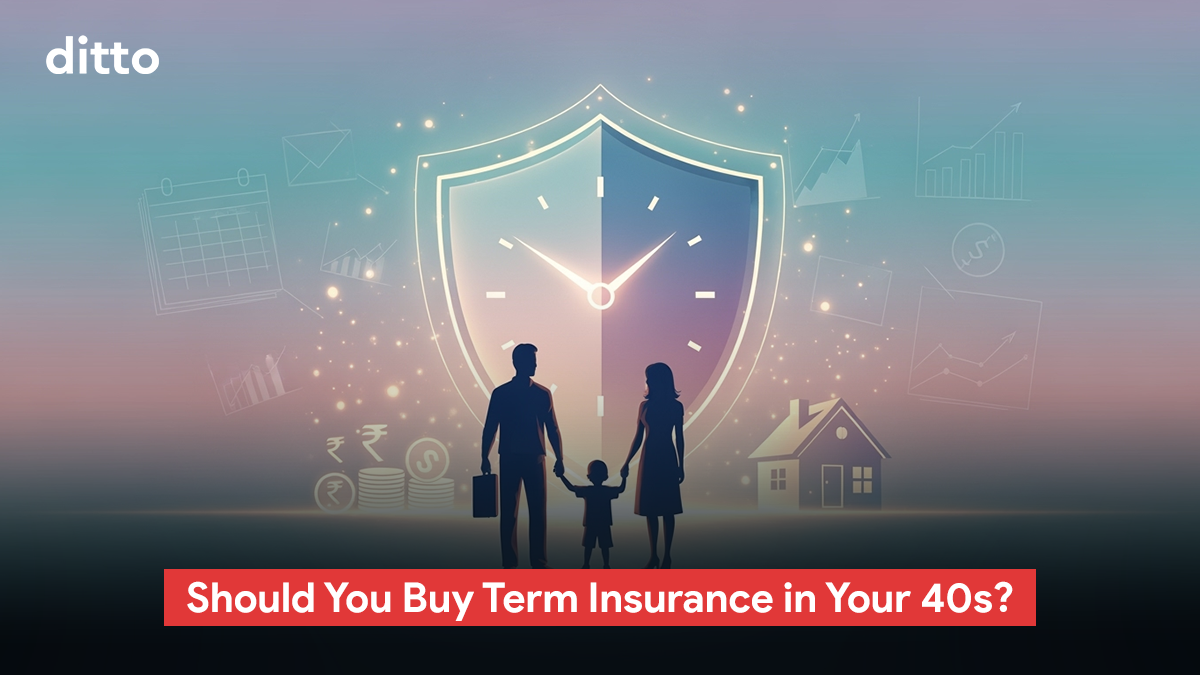Your 40s often bring the heaviest financial responsibilities of your life. You may still be repaying a housing loan, saving for your children’s education, caring for ageing parents, and at the same time, trying to build your retirement nest egg. Naturally, the big question arises: Is it too late to buy term insurance in your 40s?
At Ditto, we interact with over 1,000 mid-career professionals every month, many of whom are wrestling with this exact worry. Premiums are higher, the coverage periods are shorter, and medical tests are more stringent once you cross 40. But does that mean you should skip it altogether?
To answer this, we analysed premium charts from 15 leading insurers updated till 2025, reviewed real claim settlement cases from our advisory desk, and compared how late-entry buyers are evaluated by insurers.
By the end of this article, you’ll know whether you should still buy term insurance in your 40s, what pitfalls to avoid, and how to buy smartly despite higher costs.
A smarter move? Book a free 30‑minute consultation with Ditto’s certified advisors. No spam, no pushy sales. Just unbiased advice. Slots are limited, so book yours today.
Why Consider Term Insurance in Your 40s?
The simplest answer: because your financial responsibilities peak at this stage. Let’s break it down.
One major reason is debt protection. By 40, most individuals still carry sizeable home loans that will take another 10–15 years to repay. If something were to happen to you, those EMIs would immediately burden your spouse or children. A term plan ensures that your loans are repaid without disturbing your family’s financial stability.
Another big factor is continuity of lifestyle and education planning. Your income today likely pays not just for day-to-day bills but also long-term goals like funding higher education.
A sudden income disruption could derail these plans. For example, as one of our advisors, Archana, points out: “A single child’s overseas master’s degree can cost ₹40–60 lakh in today’s terms. Most families underestimate this while deciding their cover amount.”
Term insurance in your 40s can also help in supporting ageing parents. Many professionals at this stage are financially responsible for their parents post-retirement. A policy ensures they are not left struggling in your absence.
Finally, some buyers also take it as a way to leave behind a legacy or inheritance. Even after children become independent, a term policy can create a cushion for your spouse or an inheritance for your family without requiring huge upfront investments.
And while premiums are indeed higher compared to buying in your 20s, they are still significantly lower than what you would pay if you wait till 50. For instance, a ₹1 crore cover costs around ₹26,000 to 29,000 per year at age 40, compared to nearly ₹50,000+ a year if you buy at 50. Which means locking in your premium now prevents even steeper costs later.
How Term Insurance Premiums Rise with Age (₹1 Crore Cover Till 70)
As you’ll see below, the cost of a ₹1 crore term plan till age 70 (for a non-smoker male, including GST and without first-year discounts) rises steeply with age.
| Plan | Age 40 | Age 45 | Age 50 | Age 55 |
|---|---|---|---|---|
| HDFC Click 2 Protect Supreme | ₹29,821 | ₹38,708 | ₹53,127 | ₹65,981 |
| ICICI Iprotect Smart Plus | ₹28,163 | ₹36,591 | ₹48,888 | ₹78,247 |
| Axis Max Smart Term Plan Plus | ₹27,046 | ₹35,532 | ₹54,156 | ₹77,132 |
| Bajaj E-touch II | ₹25,850 | ₹38,215 | ₹53,943 | ₹71,799 |
Ditto’s Tip: Buying term insurance in your 40s makes sense because it covers your biggest responsibilities, such as debts, dependents, and lifestyle, at the time they matter most. As the table above shows, premiums are still fairly manageable compared to waiting until your 50s.
Buying Term Insurance in Your 40s: Key Considerations
While the need is real, buying term insurance in your 40s comes with its own set of challenges. Understanding these before you buy helps you avoid common mistakes.
The first consideration is obviously cost. Premiums jump significantly compared to your 20s and 30s. Where a 25-year-old might pay ₹12,000-14,000 annually for ₹1 crore cover, you will likely pay ₹26,000–29,000 at age 40. Despite this, it’s still the cheapest and most effective protection against financial risk. Unlike endowment or ULIP policies, term keeps costs minimal while offering the highest life cover.
Next comes your health status. At this stage, insurers begin scrutinising health conditions like diabetes, hypertension, high cholesterol, or obesity. These can increase your premiums by 25-100% depending on severity, or sometimes result in postponement/ decline of the application as well.
At Ditto, we’ve seen how borderline diabetes can increase premiums by almost 50%. One client in his 40s ended up paying ₹36,000, while another, of the same age and profession, but with no lifestyle conditions, paid only ₹24,000 for the same cover. A clear reminder that lifestyle choices directly impact your insurance costs.
Another key step is to assess your liabilities and calculate the right cover instead of picking a random “₹1 crore” plan. As a thumb rule, add up your loans, at least ten years’ worth of household expenses, and children’s future education costs. For a sample working professional with a ₹40 lakh home loan, approximately ₹96 lakh for future family expenses (₹80k/month × 10 years), and ₹35 lakh for the child’s higher education, the total required cover comes to around ₹1.45 crore.
Coverage duration is also important. Many people fall into the trap of buying plans that extend till age 85 or even 99, simply because insurers advertise them as “lifetime security.” On average, extending coverage from age 65 to 85 adds about ₹13,000–15,000 annually.
Over 25+ years, this nearly doubles the total premiums paid—a huge extra cost for protection you may not actually need. In most cases, coverage until 65–70 is sufficient, since by then your children will likely be financially independent and your loans largely repaid. Extending cover beyond this is usually unnecessary, unless you have a specific situation such as providing for a special‑needs child who may remain dependent on you.
To give you a sense of how premiums rise with higher coverage duration, here’s a comparison of popular term insurance plans. This illustration assumes a 40‑year‑old, non‑smoker, male, with a ₹1 Crore sum assured, premiums inclusive of GST and without first‑year discounts. As you’ll see, the jump in cost between coverage till 65–70 is modest, but extending it further to 80 or 85 significantly pushes up annual premiums.
| Plan | Till Age 65 | Till Age 70 | Till Age 80 | Till Age 85 |
|---|---|---|---|---|
| HDFC Click 2 Protect Supreme | ₹24,945 | ₹29,821 | ₹34,259 | ₹39,296 |
| ICICI Iprotect Smart Plus | ₹24,094 | ₹28,163 | ₹35,331 | ₹39,168 |
| Axis Max Smart Term Plan Plus | ₹22,929 | ₹27,046 | ₹34,044 | ₹37,944 |
| Bajaj E-touch II | ₹23,858 | ₹25,850 | ₹32,590 | ₹36,990 |
Finally, consider adding riders for extra protection. Riders such as Critical Illness, Accidental Death Benefit, and Waiver of Premium make more sense in your 40s than earlier in life. They add about 30-80% more to your premium but protect you against events like cancer, heart disease, or disability, which become more relevant starting this age.
When buying at 40, be precise. Calculate coverage requirements properly, restrict coverage duration till retirement, and add riders to plug key risks instead of falling for expensive gimmicks.
Buying Term Insurance in Your 40s: The Trade-Offs
Buying at this stage is not without downsides. The obvious one is cost. Paying 2–3x more than someone younger can feel painful. But think of it this way: it’s still cheaper compared to other savings-linked plans, where you’d pay 10–15x more for the same cover.
A second drawback is the shorter coverage horizon. After 40, while longer terms like 30–40 years may still be available, they tend to be very costly if the coverage extends beyond age 70.
Instead of stretching the duration, it’s often more practical to opt for a higher sum assured, ensuring your family is adequately protected during the high‑dependency early years.
Lastly, there’s the issue of medical scrutiny. Blood tests, ECGs, liver function checks, TMT (Treadmill test), and other detailed reports become standard, but note that the insurer organises these and bears their cost. Smokers, in particular, face steep premium loadings, sometimes as much as 50-100% higher than non-smokers.
While these trade-offs are real, they don’t overshadow the core benefit, financial security for your family during the most crucial dependency years.
Bottom line: Yes, it costs more and requires more tests, but the protection remains invaluable.
Why Talk to Ditto for Term Insurance?
At Ditto, we’ve assisted over 7,00,000 customers with choosing the right insurance policy. Why customers like Srinivas below love us:

✅No-Spam & No Salesmen
✅Rated 4.9/5 on Google Reviews by 15,000+ happy customers
✅Backed by Zerodha
✅100% Free Consultation
You can book a FREE consultation. Slots are running out, so make sure you book a call now!
Conclusion
So, should you buy term insurance in your 40s? The answer is yes, provided you still have financial dependents or ongoing loans. It may be late compared to your 20s or 30s, but not too late to matter. Premiums are higher, but still far cheaper than endowment or ULIP covers.
Medical tests will also be more stringent, though they ensure fairer pricing. We would recommend getting yourself tested in advance to identify any potential health issues before the insurer’s medicals. This way, you have time to address concerns and avoid surprises during underwriting.
If you’re financially independent, debt-free, and have no dependents, you can probably skip life insurance and focus on health cover and retirement investments. But if you’re like most mid-career professionals with EMIs, children, or parents depending on you, the peace of mind from a simple, well-chosen term plan is invaluable.
3 key steps to follow when buying at 40:
- Buy coverage amount based on liabilities and goals, not arbitrary figures.
- Align the coverage duration till your retirement or dependents’ independence, not “whole life.”
- Add riders for the extra risk factors most relevant in your 40s.
Still unsure about the right sum assured or duration for your case? Speak with a trusted advisor. A 30-minute discussion can save you years of extra premiums.
Last updated on:










